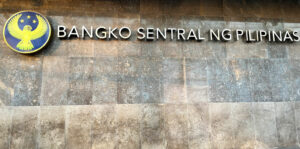TERM DEPOSIT YIELDS went down on Wednesday ahead of a widely anticipated rate cut by the Bangko Sentral ng Pilipinas (BSP) at its first policy meeting of the year.
The BSP’s term deposit facility (TDF) attracted bids amounting to P241.191 billion on Wednesday, above the P230 billion on the auction block but lower than the P274.557 billion in bids seen a week ago for the same offer volume as the one-week tenor went undersubscribed. The total award for the week stood at P219.335 billion.
Broken down, tenders for the seven-day papers reached P111.375 billion, below the P120 billion auctioned off by the central bank and the P144.992 billion in bids seen for the same offer in the previous week. The BSP accepted tenders worth P109.335 billion.
Accepted yields ranged from 5.74% to 5.785%, a slightly lower band compared with the 5.75% to 5.789% seen a week ago. This caused the average rate of the one-week deposits to drop by 1.46 basis points (bps) to 5.7608% from 5.7754% previously.
Meanwhile, bids for the 14-day term deposits amounted to P129.816 billion, higher than the P110-billion offering and the P129.565 billion in tenders for the same amount placed on the auction block a week ago. The BSP made a full P110-billion award of the tenor.
Banks asked for yields ranging from 5.74% to 5.81%, also below the 5.79% to 5.835% margin recorded a week ago. With this, the average rate for the two-week deposits went down by 3.38 bps to 5.7805% from the 5.8143% logged in the prior week’s auction of 14-day papers.
The BSP has not auctioned off 28-day term deposits since October 2020 to give way to its weekly offerings of securities with the same tenor.
The term deposits and the BSP bills are used by the central bank to mop up excess liquidity in the financial system and to bring market rates closer to the policy rate.
“The BSP TDF average auction yields were again slightly lower week on week a day before the widely expected local policy rate cut on the next BSP rate-setting meeting on Feb. 13,” Rizal Commercial Banking Corp. Chief Economist Michael L. Ricafort said in a Viber message.
A BusinessWorld poll conducted last week showed that 19 out of 20 analysts expect the Monetary Board to reduce the target reverse repurchase rate by 25 bps at its meeting on Thursday.
If realized, this would bring the benchmark rate to 5.5% from the current 5.75% and would mark the fourth straight meeting that the central bank slashed rates by 25 bps since it began its easing cycle in August 2024.
BSP Governor Eli M. Remolona, Jr. earlier said a rate cut is “on the table” this week.
He said they may slash benchmark interest rates by 50 bps this year as “policy insurance” against risks, with the cuts likely to be done in 25-bp increments each in the first and second half.
“Furthermore, the Trump administration signaled that it would prioritize policies that would help reduce the benchmark 10-year US Treasury yield instead of questioning Fed rate decisions, as partly supported by reductions in US government spending, increased US oil production that partly reduced global crude oil prices to one-month lows among three-year lows that could help support benign inflation,” Mr. Ricafort said.
This could support the US Federal Reserve’s policy easing, which could also be matched by the BSP moving forward, he added.
US Treasury Secretary Scott Bessent said in an interview with Fox Business last week that while President Donald J. Trump wants lower interest rates, he will not ask the Federal Reserve to cut rates, and that he and the president were intently focused on the 10-year Treasury yield, Reuters reported. He added that lower energy prices will help contain price pressures, while spending cuts will improve the fiscal outlook.
Benchmark 10-year Treasury yields have a direct impact on mortgage and credit card rates as well as consumer loans, while the Fed’s short-term interest rate impacts money markets and, only indirectly, borrowing costs.
But bond investors and analysts remained somewhat unconvinced by Mr. Bessent’s comments, as Mr. Trump’s trade and fiscal policies are expected to push long-term Treasury yields higher, despite lower energy prices and government spending cuts.
US Treasury yields firmed on Wednesday as investors assessed the latest US tariff salvo along with Federal Reserve Chair Jerome H. Powell’s signal of a patient path for rate cuts, Reuters reported.
Financial markets were largely biding time ahead of a reading on US consumer prices due later in the day which could guide the outlook for monetary policy there, particularly as policy makers weigh the potential inflationary impact of Mr. Trump’s tariffs on the economy.
Markets have been slowly scaling back expectations for Fed rate cuts this year, largely expecting the US central bank to hold rates steady at its March and May meetings.
Mr. Powell on Tuesday said “We are in a pretty good place with this economy,” noting that the Fed was in no hurry to make any further interest rate cuts, but stood ready to do so if inflation declines further or the job market weakens.
The Fed cut its benchmark interest rate by a full percentage point last year, but at its January meeting held rates steady in the 4.25% to 4.50% range. — Luisa Maria Jacinta C. Jocson with Reuters
